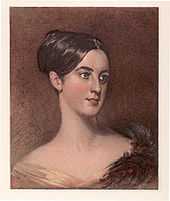Charles Augustus Murray
.JPG)
Sir Charles Augustus Murray (22 November 1806 – 3 June 1895) was a British author and diplomat.
Background
Murray was the second son of George Murray, 5th Earl of Dunmore, and his mother was the daughter of Archibald Hamilton, 9th Duke of Hamilton. He was educated at Eton College and the University of Oxford.
Murray spent several years travelling across Europe and America from 1835 and 1838, including several months with a Pawnee tribe in 1835. He described his experiences in his popular book Travels in North America (1839). He attempted to remain in the United States as Secretary of the British Legation, but failed to obtain the position. He returned to England, and wrote of the affair in a thinly-disguised novel, The Prairie-Bird (1844). On three occasions he stood as a Member of Parliament, but was unsuccessful each time, and finally obtained a position in the Court of the young Queen Victoria.
Career
After seven years, he became a diplomat in Naples. He was then consul-general in Cairo from 1846 to 1853, where he became befriended with the Ottoman Viceroy, Mehmet Ali Pasha. While stationed in Egypt, he arranged the transport of Obaysch the hippopotamus to England in 1850. Obaysch was the first hippopotamus in England since prehistoric times, and the first in Europe since Roman times. For this later feat, and his clear affection for the beast at London Zoo, he was nicknamed "Hippopotamus Murray". He also pushed forward the construction of the railway to Alexandria.
From 1853, he was for one year Minister Plenipotentiary to the Swiss Confederation[1] and was then appointed British ambassador to the Court of the Shah of Persia in 1854. The Shah, Nasser al-Din Shah, and Murray took against each other immediately. Murray's heavy-handed attitude inflamed an existing dispute over Hashim Khan, one of the Shah's bodyguards and an officer in the Persian army, who took up a position as secretary in the British embassy against the wishes of the Shah and his prime minister. Hashim Khan's wife was the subject of widespread gossip relating to Murray and his predecessor as ambassador; she was also a sister of the Shah's principal wife, so the scandal was political dynamite. Hashim Khan's wife was taken into custody by her brother on 14 November 1855, to defend her honour. Murray took this as an insult to the British legation; after demanding her release, Murray broke off diplomatic relations on 20 November. Anglo-Persian releations were already strained as the young Shah sought to annex the city Herat, a goal which had eluded the Qajar dynasty previously; and Britain for its part sought to deny such control, lest the city, considered the "Key to India," fall under the influence of Persia's patron, Russia. Murray's departure marked a break in Anglo-Persian relations and thus contributed to the outbreak of the Anglo-Persian War of 1856/7. After the war, Murray remained ambassador until 1859. He became a member of the Privy Council in 1875.

Family
On the return of his Grand Tour, he had a romantic liaison with Elizabeth Wadsworth of Geneseo, New York, but her father disapproved of the match. Elizabeth's father James Wadsworth died in 1844, and he married her on 12 December 1850 during a visit to Scotland. She died in childbirth in Cairo, Egypt on 8 December 1851, but their son survived. Murray married a second time, on 1 November 1862, to the Honourable Edith Susan Esther FitzPatrick, daughter of John FitzPatrick, 1st Baron Castletown.
External links
| Wikimedia Commons has media related to Charles Augustus Murray. |
- The causes of the Anglo-Persian War of 1856
- , , details of The Prairie-Bird
References
- ↑ The London Gazette: no. 21411. p. 407. 15 February 1853. Retrieved 11 July 2009.
| Diplomatic posts | ||
|---|---|---|
| Preceded by Andrew Buchanan |
Minister Plenipotentiary to the Swiss Confederation 1853–1854 |
Succeeded by George John Robert Gordon |
| Preceded by Augustus Paget |
British Minister to Saxony 1859 – 1866 |
Succeeded by John Lumley |
|